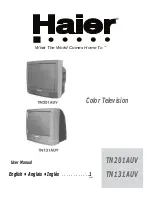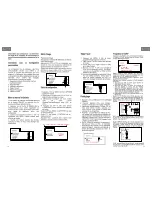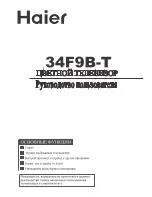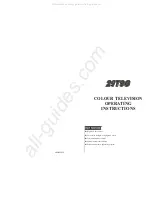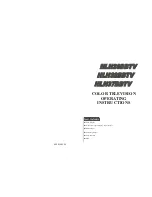
7
ENGLISH
Specialfeaturesofyour
televisionset
7
Your television set enables you to receive and
watch digital stations (via DVB-S, DVB-T and
DVB-C), including the High Definition (HD)
ones. At present, reception for these digital
television stations in High Definition is only
possible in some countries in Europe.
7
Although this television meets the current DVB-
S, DVB-T and DVB-C standards as of August
2012, its compatibility with future DVB-S
digital satellite broadcasts, DVB-T digital ter-
restrial broadcasts and DVB-C digital cable
broadcasts is not guaranteed.
7
This television can receive and process all
analogue and all unencrypted digital stations.
This television set has an integrated digital
and analogue receiver. The digital receiver
unit converts the signals from digital stations to
provide outstanding audio and picture quality.
7
The TV guide (only for digital stations) tells
you of any schedule changes at short notice,
and provides an overview of all the stations’
schedules for the next few days.
7
You can connect various data media, for
example, an external hard drive, a USB
memory stick or a digital camera to the USB
sockets. Using the file browser, you can then
select and play the file formats you want (for
example, MP4, MP3 or JPEG data).
7
SMART inter@ctive TV 4.0 provides your TV
with Internet applications when your TV is
connected to Internet.
GENERALINFORMATION
-------------------------------------------------------------------
7
Wireless USB keyboard and mouse support in
the Web browsing of your television facilitates
surfing through the internet pages for the user.
7
DLNA feature allows you to use a wired or
wireless (with wireless USN network device)
local network to access your content that
were recorded with DLNA compatible devices
we use at our daily lives such as a PC, mobile
phone or NAS (Network Attached Storage)
which are operated as DMS (Digital Medial
Server). While watching TV, you can play any
content you like at any time by using DMC
applications on your mobile device or PC
without starting DLNA application.
7
A DLNA compatible device such as a PC,
mobile phone, NAS or a NAS-like (Network
attached storage) device which operates as
a DMS (Digital Media Server) is required in
order to use home network.
Receivingdigitalstations
7
To receive digital satellite stations (DVB-S) you
need a satellite antenna.
7
To receive digital stations (DVB-T) you need
a digital rooftop or indoor antenna (passive
or active indoor antenna with its own power
supply).
7
The antenna cable of the cable TV network
that broadcast in DVB-C must be plugged into
TV in order to receive the DVB-C broadcasts.
7
Unlike analogue broadcasting, not every
station has its own transmission frequency.
Instead, several stations are grouped into
what are known as bouquets on a regional or
national level.
7
You can find the current transmission informa-
tion on teletext from various broadcasters, or
look in a TV guide or on the Internet.
7
Various digital television stations from private
broadcasters are encrypted (DVB-S, DVB-T
and DVB-C). Watching these stations and the
recording and playback functions are only
possible with the appropriate CI module and
a SmartCard. Ask your specialist dealer.























